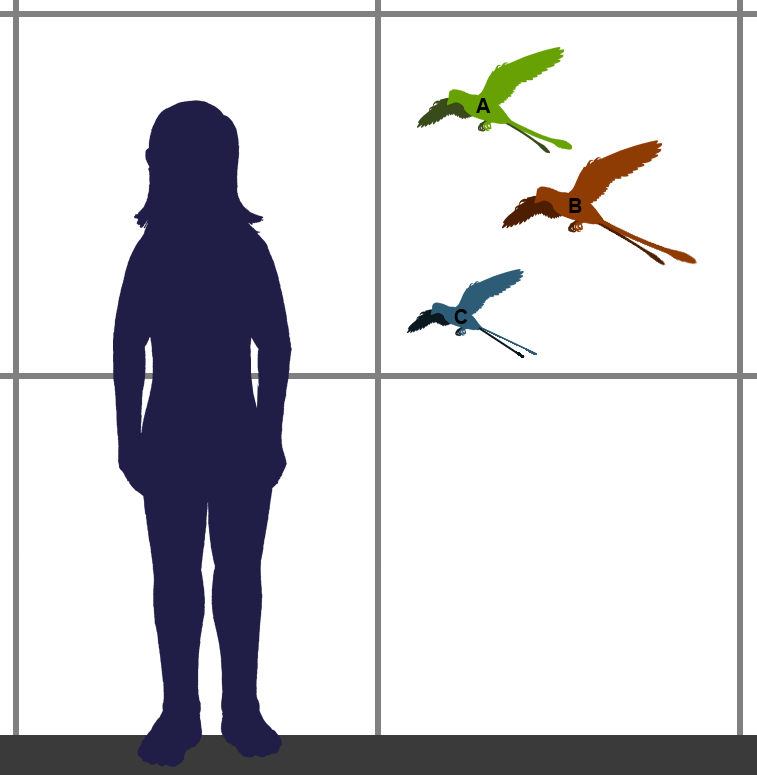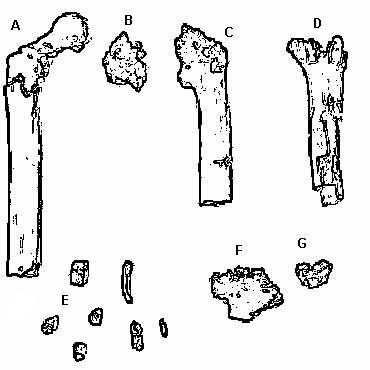|
Trachilos Footprints
The Trachilos footprints are possibly tetrapod footprints which show hominin-like characteristics from the late Miocene on the western Crete, close to the village of Trachilos, west of Kissamos, in the Chania Prefecture. Researchers describe the tracks as representing at least one apparent bipedal hominin or an unknown primate. The stratum in which the footprints were found was dated to about 5.7 million years ago, which predates the previously earliest discovered hominin footprints by about two million years. Later studies show that the footprints might be more than 6 million years old. The researchers of the tracks suggest that it may imply the possibility of hominin evolution outside of Africa, contrary to the current theory. However, there is no consensus that these impressions are distinct enough to confidently assign to a primate or even a vertebrate, or that they are indeed footprints at all. Discovery The tracks were originally discovered by Gerard D. Gierliński, from t ... [...More Info...] [...Related Items...] OR: [Wikipedia] [Google] [Baidu] |
Trachilos Fußspuren 06
Trachilos () may refer to: * Trachilos islet, a Greek islet located south of cape Goudero on the coast of Lasithi, eastern Crete. * Trachilos, a village west of Kissamos, in the Chania Prefecture at Crete. Trachilos footprints discovered near this place. * Trachilos, a beach at Sitia, on Crete. * Trachilos, a beach at the island of Kalamos Kalamos (; ) is a Greek mythological figure. He is son of Maiandros, the god of the Maeander river. Mythology A story in Nonnus's ''Dionysiaca'' tells about the love of two youths, Kalamos and Karpos. Karpos drowned in the Meander river whil .... * Trachilos Cape, at the island of Tilos. * Trachilos Cape, at the island of Antiparos. {{disambiguation, geo ... [...More Info...] [...Related Items...] OR: [Wikipedia] [Google] [Baidu] |
Foraminifera
Foraminifera ( ; Latin for "hole bearers"; informally called "forams") are unicellular organism, single-celled organisms, members of a phylum or class (biology), class of Rhizarian protists characterized by streaming granular Ectoplasm (cell biology), ectoplasm for catching food and other uses; and commonly an external shell (called a "Test (biology), test") of diverse forms and materials. Tests of chitin (found in some simple genera, and ''Textularia'' in particular) are believed to be the most primitive type. Most foraminifera are marine, the majority of which live on or within the seafloor sediment (i.e., are benthos, benthic, with different sized species playing a role within the macrobenthos, meiobenthos, and Benthos, microbenthos), while a smaller number float in the water column at various depths (i.e., are planktonic), which belong to the suborder Globigerinina. Fewer are known from freshwater or brackish conditions, and some very few (nonaquatic) soil species have been id ... [...More Info...] [...Related Items...] OR: [Wikipedia] [Google] [Baidu] |
Morphometrics
Morphometrics (from Greek μορΦή ''morphe'', "shape, form", and -μετρία ''metria'', "measurement") or morphometry refers to the quantitative analysis of ''form'', a concept that encompasses size and shape. Morphometric analyses are commonly performed on organisms, and are useful in analyzing their fossil record, the impact of mutations on shape, developmental changes in form, covariances between ecological factors and shape, as well for estimating quantitative-genetic parameters of shape. Morphometrics can be used to quantify a trait of evolutionary significance, and by detecting changes in the shape, deduce something of their ontogeny, function or evolutionary relationships. A major objective of morphometrics is to statistically test hypotheses about the factors that affect shape. "Morphometrics", in the broader sense, is also used to precisely locate certain areas of organs such as the brain, and in describing the shapes of other things. Forms Three general appro ... [...More Info...] [...Related Items...] OR: [Wikipedia] [Google] [Baidu] |
Hallux
Toes are the digits of the foot of a tetrapod. Animal species such as cats that walk on their toes are described as being ''digitigrade''. Humans, and other animals that walk on the soles of their feet, are described as being ''plantigrade''; '' unguligrade'' animals are those that walk on hooves at the tips of their toes. Structure There are normally five toes present on each human foot. Each toe consists of three phalanx bones, the proximal, middle, and distal, with the exception of the big toe (). For a minority of people, the little toe also is missing a middle bone. The hallux only contains two phalanx bones, the proximal and distal. The joints between each phalanx are the interphalangeal joints. The proximal phalanx bone of each toe articulates with the metatarsal bone of the foot at the metatarsophalangeal joint. Each toe is surrounded by skin, and present on all five toes is a toenail. The toes are, from medial to lateral: * the first toe, also known as the h ... [...More Info...] [...Related Items...] OR: [Wikipedia] [Google] [Baidu] |
Dactyly
In biology, dactyly is the arrangement of digits (fingers and toes) on the hands, feet, or sometimes wings of a tetrapod animal. The term is derived from the Greek word () meaning "finger." Sometimes the suffix "-dactylia" is used. The derived adjectives end with "-dactyl" or "-dactylous." As a normal feature Pentadactyly Pentadactyly (from Greek "five") is the condition of having five digits on each limb. It is traditionally believed that all living tetrapods are descended from an ancestor with a pentadactyl limb, although many species have now lost or transformed some or all of their digits by the process of evolution. However, this viewpoint was challenged by Stephen Jay Gould in his 1991 essay "Eight (or Fewer) Little Piggies," where he pointed out polydactyly in early tetrapods and described the specializations of digit reduction. Despite the individual variations listed below, the relationship is to the original five-digit model. In reptiles, the limbs are pentad ... [...More Info...] [...Related Items...] OR: [Wikipedia] [Google] [Baidu] |
Plantigrade
151px, Portion of a human skeleton, showing plantigrade habit In terrestrial animals, plantigrade locomotion means walking with the toes and metatarsals flat on the ground. It is one of three forms of locomotion adopted by terrestrial mammals. The other options are digitigrade, walking on the toes and fingers with the heel and wrist permanently raised, and unguligrade, walking on the nail or nails of the toes (the hoof) with the heel/wrist and the digits permanently raised. The leg of a plantigrade mammal includes the bones of the upper leg (femur/humerus) and lower leg (tibia and fibula/radius and ulna). The leg of a digitigrade mammal also includes the metatarsals/metacarpals, the bones that in a human compose the arch of the foot and the palm of the hand. The leg of an unguligrade mammal also includes the phalanges, the finger and toe bones. Among extinct animals, most early mammals such as pantodonts were plantigrade. A plantigrade foot is the primitive condition ... [...More Info...] [...Related Items...] OR: [Wikipedia] [Google] [Baidu] |
Kenya
Kenya, officially the Republic of Kenya, is a country located in East Africa. With an estimated population of more than 52.4 million as of mid-2024, Kenya is the 27th-most-populous country in the world and the 7th most populous in Africa. Kenya's capital and largest city is Nairobi. Its second-largest and oldest city is Mombasa, a major port city located on Mombasa Island. Other major cities within the country include Kisumu, Nakuru & Eldoret. Going clockwise, Kenya is bordered by South Sudan to the northwest (though much of that border includes the disputed Ilemi Triangle), Ethiopia to the north, Somalia to the east, the Indian Ocean to the southeast, Tanzania to the southwest, and Lake Victoria and Uganda to the west. Kenya's geography, climate and population vary widely. In western, rift valley counties, the landscape includes cold, snow-capped mountaintops (such as Batian, Nelion and Point Lenana on Mount Kenya) with vast surrounding forests, wildlife and ... [...More Info...] [...Related Items...] OR: [Wikipedia] [Google] [Baidu] |
Orrorin
''Orrorin'' is an extinct genus of primate within Homininae from the Miocene Lukeino Formation and Pliocene Mabaget Formation, both of Kenya. The type species is ''O. tugenenesis'', named in 2001, and a second species, ''O. praegens'', assigned to the genus in 2022. Discovery and naming ''Ororrin tugenensis'' The first part of the holotype, a lower molar, was discovered by Martin Pickford in 1974 and described by Pickford (1975). The team that found the rest of the holotype of ''O. tugenensis'' was led by Brigitte Senut and Martin Pickford from the French National Museum of Natural History. Starting from 17 October 2000, 20 fossils were found at four sites in the Lukeino Formation, Kenya: of these, the fossils at Cheboit and Aragai are the oldest (), while those in Kapsomin and Kapcheberek are found in the upper levels of the formation (). ''Orrorin tugenensis'' was named and described by Senut ''et al.'' (2001). ''Orrorin praegens'' The second species, ''O. ... [...More Info...] [...Related Items...] OR: [Wikipedia] [Google] [Baidu] |
Magnetic Susceptibility
In electromagnetism, the magnetic susceptibility (; denoted , chi) is a measure of how much a material will become magnetized in an applied magnetic field. It is the ratio of magnetization (magnetic moment per unit volume) to the applied magnetic field intensity . This allows a simple classification, into two categories, of most materials' responses to an applied magnetic field: an alignment with the magnetic field, , called paramagnetism, or an alignment against the field, , called diamagnetism. Magnetic susceptibility indicates whether a material is attracted into or repelled out of a magnetic field. Paramagnetic materials align with the applied field and are attracted to regions of greater magnetic field. Diamagnetic materials are anti-aligned and are pushed away, toward regions of lower magnetic fields. On top of the applied field, the magnetization of the material adds its own magnetic field, causing the field lines to concentrate in paramagnetism, or be excluded in diamagn ... [...More Info...] [...Related Items...] OR: [Wikipedia] [Google] [Baidu] |
Cyclostratigraphy
Cyclostratigraphy is a subdiscipline of stratigraphy that studies astronomically forced climate cycles within sedimentary successions. Orbital changes Astronomical cycles (also known as Milankovitch cycles) are variations of the Earth's orbit around the Sun due to the gravitational interaction with other masses within the Solar System. Due to this cyclicity, solar irradiation differs through time on different hemispheres and seasonality is affected. These insolation variations have influence on Earth's climate and on the deposition of sedimentary rocks. The main orbital cycles are precession with main periods of 19 and 23 kyr, obliquity with main periods of 41 kyr, and 1.2 Myr, and eccentricity with main periods of around 100 kyr, 405 kyr, and 2.4 Myr. Precession influences how much insolation each hemisphere receives. Obliquity controls the intensity of the seasons. Eccentricity influences how much insolation the Earth receives altogether. Varied insolation directly infl ... [...More Info...] [...Related Items...] OR: [Wikipedia] [Google] [Baidu] |
Messinian Salinity Crisis
In the Messinian salinity crisis (also referred to as the Messinian event, and in its latest stage as the Lago Mare event) the Mediterranean Sea went into a cycle of partial or nearly complete desiccation (drying-up) throughout the latter part of the Messinian age of the Miocene epoch, from 5.96 to 5.33 Year#SI prefix multipliers, Ma (million years ago). It ended with the Zanclean flood, when the Atlantic reclaimed the basin. Sediment samples from below the deep seafloor of the Mediterranean Sea, which include evaporite minerals, soils, and fossil plants, show that the precursor of the Strait of Gibraltar closed about 5.96 million years ago, sealing the Mediterranean off from the Atlantic. This resulted in a period of partial desiccation of the Mediterranean Sea, the first of several such periods during the late Miocene. After the strait closed for the last time around 5.6 Ma, the region's generally dry climate at the time dried the Mediterranean basin out nearly completely within ... [...More Info...] [...Related Items...] OR: [Wikipedia] [Google] [Baidu] |





